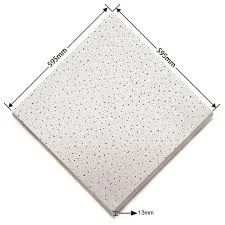- Afrikaans
- Albanian
- Amharic
- Arabic
- Armenian
- Azerbaijani
- Basque
- Belarusian
- Bengali
- Bosnian
- Bulgarian
- Catalan
- Cebuano
- Corsican
- Croatian
- Czech
- Danish
- Dutch
- English
- Esperanto
- Estonian
- French
- German
- Greek
- Hindi
- Indonesian
- irish
- Italian
- Japanese
- Korean
- Lao
- Malay
- Myanmar
- Norwegian
- Norwegian
- Polish
- Portuguese
- Romanian
- Russian
- Serbian
- Spanish
- Swedish
- Thai
- Turkish
- Ukrainian
- Uzbek
- Vietnamese
Dhj . 13, 2024 03:15 Back to list
Specifications for Mineral Fiber Ceiling Boards for Optimal Performance and Aesthetics
Mineral Fiber Ceiling Board Specifications An Essential Guide
Mineral fiber ceiling boards have gained substantial popularity in both residential and commercial construction due to their excellent acoustic properties, aesthetic appeal, and fire resistance. As buildings evolve and the demand for sustainable materials increases, understanding the specifications of mineral fiber ceiling boards becomes crucial for architects, builders, and interior designers. This article aims to provide a comprehensive overview of the key specifications and characteristics of mineral fiber ceiling boards.
Composition and Manufacturing
Mineral fiber ceiling boards are primarily composed of natural and synthetic fibers, which may include fiberglass, cellulose, and various mineral aggregates. The manufacturing process typically involves mixing these materials with binders and additives, followed by shaping and curing to form dense panel boards. Such composition ensures that mineral fiber ceiling boards are lightweight yet sturdy, making them easy to install in various ceilings.
Acoustic Performance
One of the standout features of mineral fiber ceiling boards is their exceptional sound absorption capabilities. The Noise Reduction Coefficient (NRC) is a critical metric used to measure these capabilities. NRC ratings typically range from 0.60 to 0.95, meaning that these boards can absorb between 60% to 95% of sound energy. This characteristic makes them particularly suitable for environments such as offices, classrooms, and auditoriums, where controlling acoustics is vital for productivity and communication.
Fire Resistance
Mineral fiber ceiling boards are inherently fire-resistant, an attribute that is crucial for meeting building code requirements. Most boards achieve a Class A fire rating, indicating that they can withstand high temperatures without releasing harmful smoke or toxins. This characteristic not only contributes to occupant safety but also helps in the protection of property, making mineral fiber an ideal choice for commercial and institutional buildings.
Thermal Insulation
mineral fiber ceiling board specification

In addition to their acoustic and fire-resistant properties, mineral fiber ceiling boards offer good thermal insulation. This feature aids in energy efficiency as it helps maintain stable indoor temperatures, reducing heating and cooling costs. The thermal resistance, often measured in R-values, contributes significantly to the overall sustainability of a building.
Aesthetic Versatility
Mineral fiber ceiling boards come in various textures, colors, and designs, adding aesthetic value to any space. Whether it's a smooth, sleek finish or a more textured appearance, these boards can complement various architectural styles. Further, they can be easily painted or customized, allowing designers the flexibility to achieve the desired look for any project.
Installation and Maintenance
The installation of mineral fiber ceiling boards is relatively straightforward, often employed in a suspended ceiling system. This system allows for easy access to plumbing and electrical infrastructure, enhancing convenience in maintenance and repairs. Moreover, they are easy to clean and maintain, typically requiring just periodic dusting or gentle washing to keep them looking fresh and new.
Environmental Considerations
In today’s eco-conscious world, the sustainability of building materials is at the forefront of many designers’ and builders’ minds. Many mineral fiber ceiling boards are manufactured using recycled materials and are themselves recyclable at the end of their life span. This aligns with green building practices and helps reduce the environmental impact of new constructions.
Conclusion
In summary, mineral fiber ceiling boards are a versatile and practical choice for many construction projects, combining aesthetic appeal with functional benefits such as sound absorption, fire resistance, and thermal insulation. Understanding their specifications — including composition, acoustic performance, fire ratings, and installation considerations — is essential for making informed decisions in building design and renovation. As the construction industry continues to evolve, the adoption of sustainable and efficient materials like mineral fiber ceiling boards will likely play a crucial role in shaping the built environment of the future.
-
Transform Interiors with PVC Gypsum Ceiling: A Stylish, Durable, and Moisture-Resistant SolutionNewsMay.19,2025
-
The Smart Interior Upgrade: Discover the Durability and Versatility of Gypsum Ceiling Access Panel SolutionsNewsMay.19,2025
-
The Smart Choice for Interior Design: Discover the Value of PVC Gypsum Ceiling SolutionsNewsMay.19,2025
-
Mineral Fiber Ceiling Tiles: The Smart Blend of Performance and AestheticsNewsMay.19,2025
-
Mineral Fiber Ceiling Tiles: The Superior Choice Over Gypsum for Sound and Fire SafetyNewsMay.19,2025
-
Mineral Fiber Ceiling Tiles: Eco-Friendly Strength and Style for Every CeilingNewsMay.19,2025







